Euro nymphing and indicator nymphing are two popular techniques used in trout fishing. Both have their pros and cons, and understanding the differences between them can help anglers choose the right approach for their fishing needs. In this article, we will compare and contrast Euro nymphing and indicator nymphing, exploring the techniques, styles, and setups associated with each method.
Key Takeaways:
- Euro nymphing and indicator nymphing are two popular techniques used in trout fishing.
- Understanding the differences between Euro nymphing and indicator nymphing can help anglers choose the right approach for their fishing needs.
- Euro nymphing involves using a long, lightweight rod and a thin, sensitive fly line, while indicator nymphing uses a buoyant indicator to suspend nymphs at a specific depth.
- Euro nymphing offers precise control, sensitive strike detection, and improved hook sets, while indicator nymphing is more forgiving and beginner-friendly.
- Factors such as skill level, fishing conditions, and target species should be considered when choosing between Euro nymphing and indicator nymphing.
What is Euro Nymphing?
Euro nymphing, also known as tight line nymphing or French nymphing, is a highly effective technique used by fly anglers to target trout in rivers and streams. This method involves using a long, lightweight rod and a thin, sensitive fly line, allowing for enhanced sensitivity and control during the presentation.
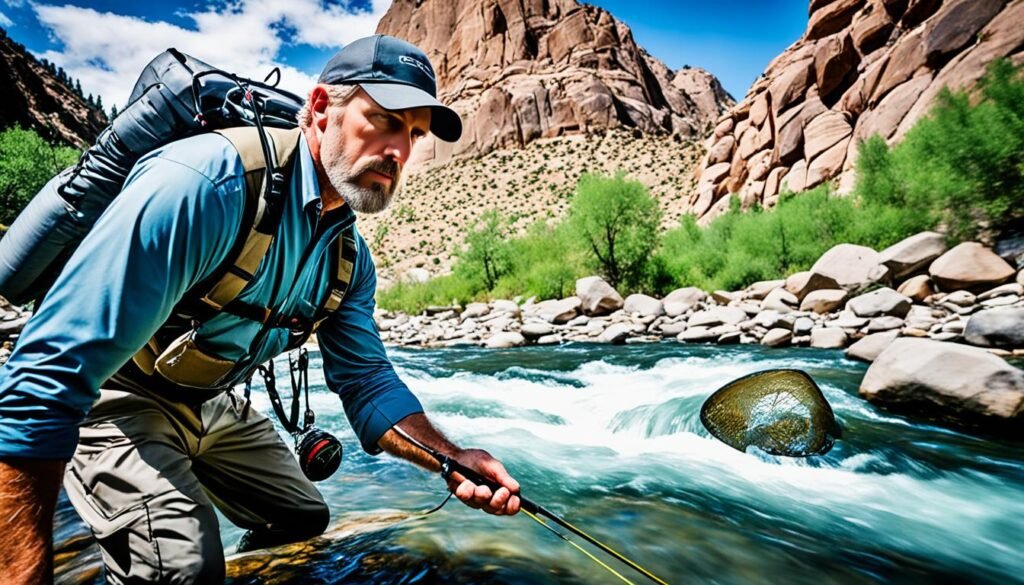
“Euro nymphing relies on the weight of the flies and the tension of the line to detect even the most subtle strikes from trout.”
Unlike traditional nymphing techniques that rely on indicators, Euro nymphing relies on the angler’s ability to maintain direct contact with the fly and detect strikes through subtle line movements and changes in tension. By minimizing the amount of slack or drag in the line, anglers can achieve a more natural presentation and increase their chances of landing fish.
Euro nymphing setups typically consist of long leaders, thin tippet material, and heavily weighted flies. The long leader allows for better control and precision, while the thin tippet material ensures a delicate presentation. The use of heavily weighted flies helps the angler get down into the desired depth quickly and effectively.
One of the key advantages of Euro nymphing is the ability to fish at various depths in the water column with incredible accuracy. By adjusting the length of the leader and the weight of the flies, anglers can target specific feeding zones, maximizing their chances of success. This makes Euro nymphing particularly effective in fast-moving water, where trout are often found at different depths.
Furthermore, Euro nymphing allows for a more intuitive and immersive fishing experience. Anglers are in constant touch with their flies and have direct control over their presentation, making it easier to detect strikes and set the hook at the right time.
To excel at Euro nymphing, anglers need to develop a delicate touch and refine their ability to interpret subtle line movements. It requires practice and patience to master this technique, but the rewards in terms of increased catch rates and a deeper connection with the water are well worth the effort.
Advantages of Euro Nymphing:
- Precise control and presentation
- Enhanced sensitivity to strikes
- The ability to fish at various depths
- Increased catch rates in fast-moving water
- Immersion in the fishing experience
Now that we have explored Euro nymphing, let’s dive into the world of indicator nymphing in the next section.
What is Indicator Nymphing?
Indicator nymphing, also known as traditional nymphing or strike indicator fishing, is a technique that allows anglers to present nymphs at specific depths in the water column. By using a buoyant indicator, such as a small foam or yarn indicator, anglers can suspend nymphs at a desired depth and monitor the indicator for any indications of a fish taking the fly.
This method is favored by anglers who prefer a more visual and passive approach to nymphing. It allows them to cast their flies upstream and let them drift naturally downstream, while keeping a close eye on the indicator. When the indicator twitches, dips, or moves out of its natural position, it signals a possible strike, prompting the angler to set the hook. This technique offers an exciting and engaging way to target trout.
“Indicator nymphing is like having a little detective in the water, telling you when a fish is interested in your fly.” – John Roberts, avid angler
An indicator nymphing rig typically consists of a weighted fly, a length of tippet, and a strike indicator attached to the leader. The weighted fly helps to sink the nymphs to the desired depth, while the strike indicator keeps the nymphs suspended and provides a visual cue for strikes. The tippet, usually made of thin monofilament or fluorocarbon material, connects the fly to the leader, allowing for a natural presentation.
When selecting a strike indicator, anglers have a variety of options to choose from. Some popular choices include small foam indicators, yarn indicators, or even dry flies used as indicators. The size and buoyancy of the indicator will depend on the water conditions and the size of the flies being used.
Overall, indicator nymphing is a versatile and effective technique for targeting trout in various water conditions. It allows anglers to present nymphs at specific depths, making it suitable for fishing in streams, rivers, and stillwaters. The visual aspect of indicator nymphing adds an element of excitement and anticipation to the fishing experience, making it a popular choice among fly anglers.
| Pros of Indicator Nymphing | Cons of Indicator Nymphing |
|---|---|
|
|
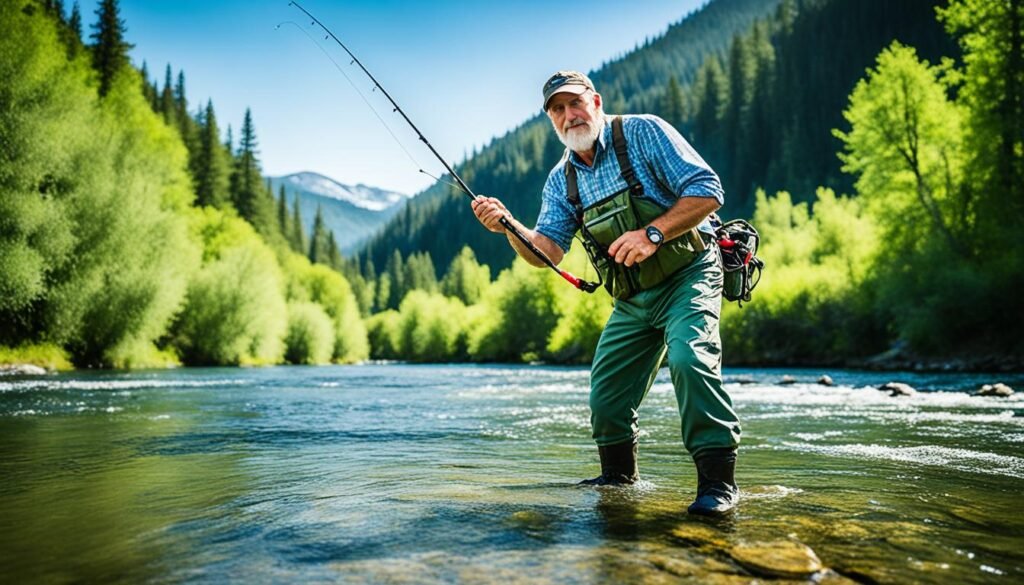
Pros and Cons of Euro Nymphing
Euro nymphing is a popular technique among trout anglers, offering several advantages that enhance the fishing experience. However, like any method, it also has its limitations. Let’s explore the pros and cons of Euro nymphing:
Pros of Euro Nymphing
- Precise Control: The use of a thin fly line and direct contact with the nymphs allows anglers to have precise control over their presentation. This enables accurate placement of the flies and increases the chances of enticing trout to strike.
- Sensitive Strike Detection: With Euro nymphing, anglers have a heightened sense of strike detection. The direct contact with the nymphs allows for instant recognition of subtle strikes, enabling anglers to react quickly and set the hook effectively.
- Improved Hook Sets: The direct contact and sensitivity of the technique result in improved hook sets. Anglers can feel even the slightest nibble or take, ensuring they can set the hook with the right timing and force.
- Effective in Fast-Moving Water: Euro nymphing is particularly effective in fast-moving water, where the thin fly line and direct contact provide better control and fly drift in strong currents.
- Target Specific Depths: Euro nymphing allows anglers to target specific depths in the water column. By adjusting the length of the leader and the weight of the flies, anglers can effectively fish in various water depths.
Cons of Euro Nymphing
- Requires Skill and Finesse: Euro nymphing requires a certain level of skill and finesse to master. The technique involves delicate presentations and precise line control, which may take time and practice to perfect.
- Less Suitable for Deep or Still Water: While Euro nymphing excels in fast-moving water, it may not be as effective in deep or still water. The thin fly line and direct contact may not allow for the same level of control and sensitivity in these fishing conditions.
Despite its limitations, Euro nymphing remains a valuable technique for trout anglers, especially in certain fishing scenarios. Understanding its pros and cons can help anglers make informed decisions and maximize their success on the water.
Pros and Cons of Indicator Nymphing
Indicator nymphing, also known as traditional nymphing or strike indicator fishing, has its own set of advantages and disadvantages.
Advantages of Indicator Nymphing
- Easier Strike Detection: Utilizing a strike indicator makes it easier for anglers to detect strikes, especially in turbulent or choppy water. The subtle movement or disappearance of the indicator reveals when a fish takes the fly, providing timely opportunities for a hookup.
- Beginner-Friendly: Indicator nymphing is more forgiving and beginner-friendly, often making it the preferred technique for novice anglers. The visual cue of the indicator allows beginners to easily track their fly and observe any potential action from trout.
Disadvantages of Indicator Nymphing
- Potential Spooking of Fish: While the use of an indicator aids in strike detection, it can also have the unintended effect of spooking fish. The presence of an indicator on the surface may alert trout to the unnatural aspect of the presentation, causing them to become wary and less likely to strike.
- Reliance on Visual Cues: Indicator nymphing relies heavily on visual cues to detect strikes, which can lead to missed opportunities. Trout strikes may not always result in visible movements of the indicator, making it crucial for anglers to maintain constant focus and concentration.
- Ineffectiveness in Faster or Deeper Water: Indicator nymphing may not be as effective in faster or deeper water conditions. The drag caused by the indicator can limit the natural drift of the nymphs, reducing their attractiveness to trout in swifter currents or deeper pools.
Despite these drawbacks, indicator nymphing remains a popular choice for many anglers due to its ease of use and effectiveness in certain fishing situations.
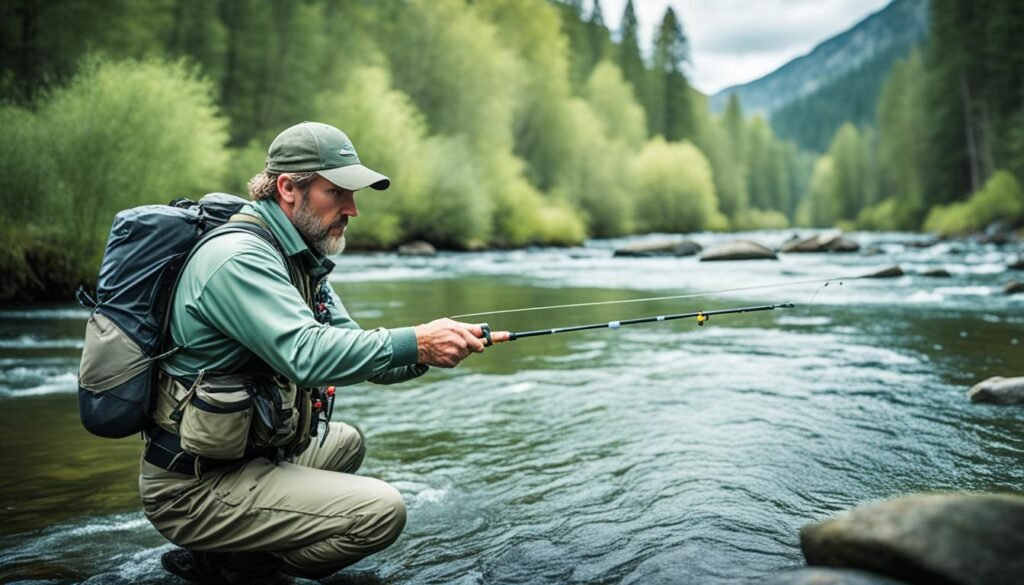
Next, we will discuss the factors to consider when choosing between Euro nymphing and indicator nymphing.
Choosing the Right Technique for Your Fishing Needs
When it comes to nymphing techniques, choosing between Euro nymphing and indicator nymphing requires careful consideration. Several factors play a role in determining the most suitable technique, including your skill level, fishing conditions, and target species. Let’s explore the key differences and factors to help you make an informed decision.
Euro Nymphing
Euro nymphing, also known as tight line nymphing or French nymphing, is favored by experienced anglers who prioritize precision and control. With Euro nymphing, you’ll use a long, lightweight rod and a thin, sensitive fly line to maintain close contact with your fly. This technique allows for precise control and presentation, making it ideal for fishing in faster-moving water. Euro nymphing setups typically consist of long leaders, thin tippet material, and heavily weighted flies.
Indicator Nymphing
Indicator nymphing, also known as traditional nymphing or strike indicator fishing, is a popular choice among beginners and anglers fishing in slower water. This technique involves suspending nymphs at a specific depth using a buoyant indicator. Anglers cast their flies upstream and rely on the indicator to detect strikes. Indicator nymphing is a more visual and passive approach, allowing anglers to watch for any signs of fish taking the fly. Typical setups include a weighted fly, a tippet, and a strike indicator attached to the leader.
Now, let’s consider the factors that can help you decide which nymphing technique is right for you:
- Skill Level: If you’re an experienced angler looking for precise control and finesse, Euro nymphing may be your preferred technique. On the other hand, if you’re a beginner or prefer a more relaxed approach, indicator nymphing can be a great starting point.
- Fishing Conditions: Consider the speed of the water you’ll be fishing in. Euro nymphing is more effective in fast-moving water, while indicator nymphing works well in slower currents.
- Target Species: Different nymphing techniques may be more suitable for specific fish species. Research the behavior and feeding habits of your target species to determine which technique aligns best with their preferences.
Ultimately, the best approach is to experiment with both techniques and adapt them to your fishing situations. You may find that certain conditions or fishing scenarios favor one technique over the other. Don’t be afraid to try different setups, adjust your leader length or fly weight, and customize your approach to maximize your success on the water.
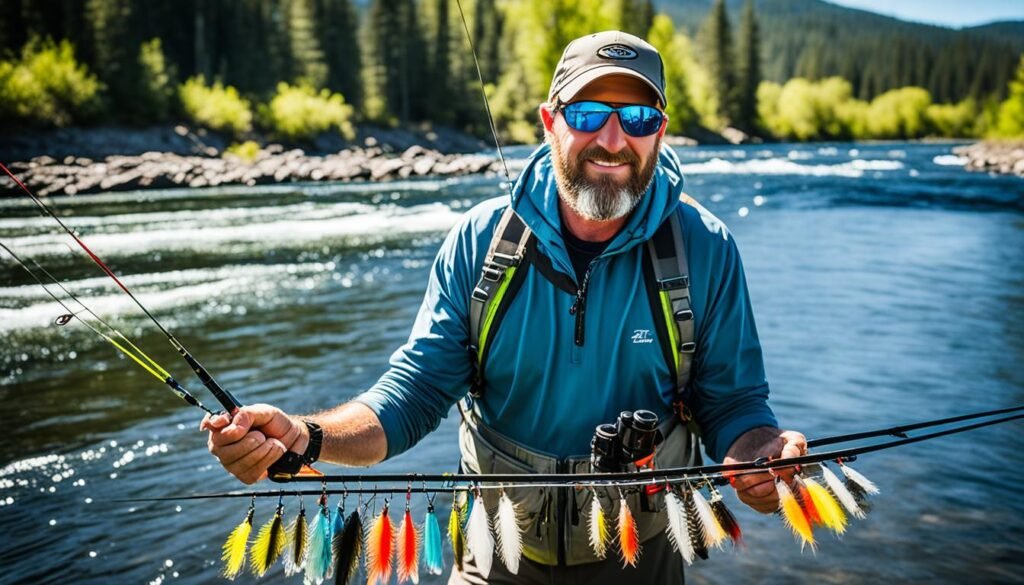
By considering your skill level, fishing conditions, and target species, you can confidently choose the nymphing technique that best suits your fishing needs. Whether you opt for Euro nymphing or indicator nymphing, remember to practice, be patient, and enjoy the thrill of landing trout with these effective nymphing techniques.
Tips and Tricks for Successful Nymphing
Regardless of the nymphing technique used, there are several tips and tricks that can improve your success on the water. Whether you’re a beginner or a seasoned angler, these strategies will help you become a proficient nymph angler and maximize your chances of catching trout.
- Choose the right flies: Selecting the appropriate nymph flies is crucial for nymphing success. Take into consideration the current hatch, water conditions, and the preferences of the fish. Carry a variety of nymph patterns in different sizes and colors to match the insects the trout are feeding on.
- Adjust the depth and weight of the nymphs: Experiment with different depths and weights to present your nymphs at the desired level in the water column. Use split shot or tungsten bead-head flies to add weight and achieve the desired sinking rate.
- Master the art of a natural drift: A drag-free drift is essential for fooling trout. Mend your line and leader upstream to achieve a natural presentation. Pay attention to the speed and direction of the current, adjusting your line accordingly to maintain a realistic drift.
- Read the water: Understanding the different features of the water, such as riffles, runs, and pools, can help you locate trout and determine where to present your nymphs effectively. Look for areas with structure, such as rocks or logs, which provide cover for trout.
- Observe trout behavior: Keep a keen eye on the water and observe how trout interact with their environment. Look for rising fish, swirling water, or subtle boils that indicate trout feeding. Pay attention to their feeding patterns and adjust your nymphing strategy accordingly.
- Be patient: Nymphing requires patience and persistence. Allow your nymphs enough time to sink to the desired depth and present them for an extended period in each likely feeding area. Don’t be in a rush to move on; sometimes, trout need a little extra time to commit to taking the fly.
Remember, successful nymphing takes practice and experimentation. Continuously refine your techniques, adapt to changing conditions, and learn from each fishing experience. With time and dedication, you’ll develop your own nymphing style and become a skilled angler on the water.

Gear and Equipment for Nymphing
Nymphing requires specific gear and equipment to enhance an angler’s success. Whether you’re practicing Euro nymphing or indicator nymphing, having the right tools can make all the difference in your fishing experience.
Euro Nymphing Gear
When it comes to Euro nymphing, your gear needs to be finely tuned for detecting strikes and maintaining control. Here are the essentials:
- A long, lightweight rod with a sensitive tip allows you to feel even the slightest bites. Look for a rod that is specifically designed for nymphing techniques.
- Thin diameter fly lines with little to no weight are ideal for Euro nymphing. These lines offer a direct connection to your flies, maximizing sensitivity and strike detection.
- Long leaders made of fluorocarbon or monofilament give your flies a natural drift and allow you to present them effectively to trout.
- Light tippet material is crucial for Euro nymphing, as it allows your flies to sink quickly and maintain a natural presentation.
Indicator Nymphing Gear
If you prefer indicator nymphing, your gear needs to support casting the rig and setting the hook while still providing visual cues. Here’s what you’ll need:
- A rod with enough backbone to handle casting the rig and setting the hook is essential for indicator nymphing. Look for a rod with a sturdy construction and enough power to handle larger fish.
- Strike indicators, also known as bobbers, are used to suspend your nymphs at a specific depth. They come in various sizes and materials, allowing you to choose the right one for your fishing conditions.
- Weighted nymphs are crucial for getting your flies down in the water column. Choose nymph patterns with the appropriate weight to match the depth you’re fishing.
- Proper leader setups with the right combination of tippet material and fly attachments are essential for presenting your nymphs effectively. Experiment with different configurations to find the best setup for your specific fishing situation.
Choosing the right gear and equipment for nymphing can greatly improve your chances of success on the water. Whether you opt for Euro nymphing or indicator nymphing, having the appropriate tools will enhance your nymphing performance and increase your chances of landing more trout.
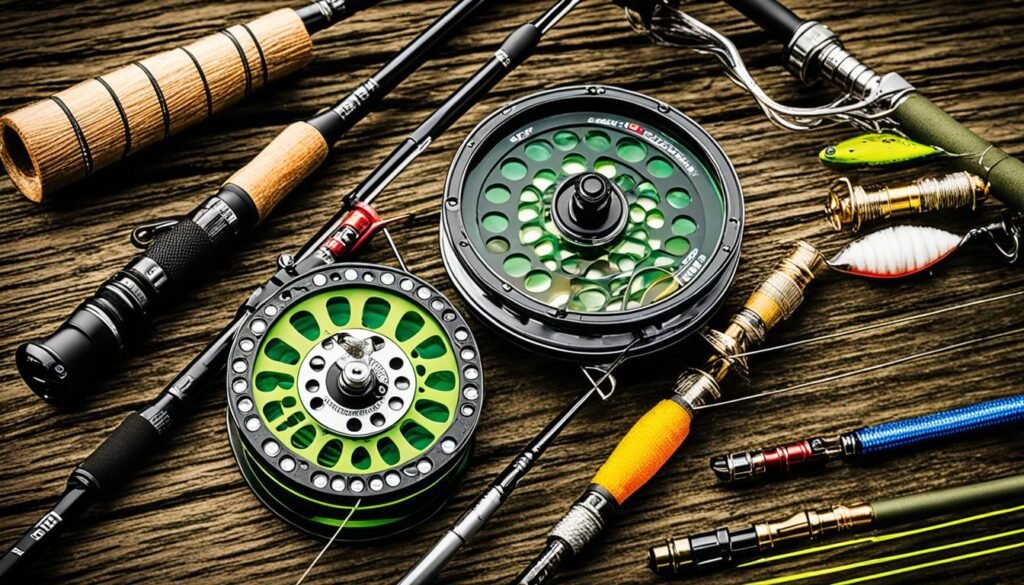
Conclusion
Euro nymphing and indicator nymphing are two highly effective techniques for trout fishing. Each method has its unique advantages and limitations, making the choice between them a matter of personal preference, fishing conditions, and target species.
For anglers seeking precision, control, and the ability to target specific depths in fast-moving water, Euro nymphing is a superb choice. With its long, lightweight rods, sensitive fly lines, and weighted flies, Euro nymphing allows anglers to closely monitor their flies and detect even the subtlest strikes from trout.
On the other hand, indicator nymphing appeals to anglers who prefer a more visual and passive approach. Using a buoyant indicator, anglers suspend nymphs at a desired depth and watch for any signs of trout taking the fly. Indicator nymphing is beginner-friendly and excels in slower water, making it an excellent technique for novice anglers or those fishing in calmer conditions.
Ultimately, successful nymphing requires experimentation, practice, and adaptation. Anglers should strive to develop their own nymphing style, blending elements from both Euro nymphing and indicator nymphing to suit their specific fishing situations. By honing their skills and gaining experience, anglers can improve their overall nymphing game and enhance their trout fishing success.
FAQ
What is Euro nymphing?
Euro nymphing, also known as tight line nymphing or French nymphing, is a technique that involves using a long, lightweight rod and a thin, sensitive fly line. Anglers rely on the weight of the flies and the tension of the line to detect subtle strikes from trout. This method requires close contact with the fly, allowing for precise control and presentation.
What is indicator nymphing?
Indicator nymphing, also known as traditional nymphing or strike indicator fishing, is a technique that involves using a buoyant indicator to suspend nymphs at a specific depth in the water column. Anglers cast their flies upstream and allow them to drift naturally, watching the indicator for any signs of a fish taking the fly. This method is popular among anglers who prefer a more visual and passive approach to nymphing.
What are the pros and cons of Euro nymphing?
Euro nymphing offers precise control, sensitive strike detection, and improved hook sets. It is effective in fast-moving water and allows for targeting specific depths in the water column. However, it requires more skill and finesse to master and may not be as suitable for fishing in deep or still water.
What are the pros and cons of indicator nymphing?
Indicator nymphing makes it easier to detect strikes, especially in turbulent water, and is beginner-friendly. However, it can spook fish, may result in missed strikes, and may not be as effective in faster or deeper water.
How do I choose the right nymphing technique?
The choice between Euro nymphing and indicator nymphing depends on factors such as skill level, fishing conditions, and target species. Experienced anglers who prioritize precision and control may prefer Euro nymphing, while beginners or anglers fishing in slower water may find indicator nymphing more effective. It is important to experiment with both techniques and adapt them to individual fishing situations.
What are some tips and tricks for successful nymphing?
Some tips for successful nymphing include choosing the right flies, adjusting the depth and weight of the nymphs, and using a natural drift. Additionally, reading the water, understanding trout behavior, and staying patient are crucial for successful nymphing. Practice and experimentation are key to becoming a proficient nymph angler.
What gear and equipment do I need for nymphing?
In Euro nymphing, a long, lightweight rod with a sensitive tip, thin fly lines, long leaders, and light tippet material are necessary. Indicator nymphing requires rods with enough backbone, strike indicators, weighted nymphs, and appropriate leader setups. Choosing the right gear and equipment can greatly enhance nymphing performance.
What is the difference between Euro nymphing and indicator nymphing?
Euro nymphing relies on direct contact and precise control, while indicator nymphing uses a buoyant indicator to suspend nymphs. Euro nymphing can be more effective in fast-moving water and offers sensitive strike detection, while indicator nymphing is more beginner-friendly and offers easier strike detection in turbulent water.
Can I use Euro nymphing or indicator nymphing in any fishing situation?
The suitability of Euro nymphing or indicator nymphing depends on factors such as fishing conditions and target species. Euro nymphing is ideal for precision and control in fast-moving water, while indicator nymphing is more suitable for slower water and situations where easier strike detection is desired.

